ploeh blog danish software design
Functional design is intrinsically testable
TDD with Functional Programming doesn't lead to test-induced damage. Here's why.
Over the years, there's been much criticism of Test-Driven Development (TDD). Perhaps David Heinemeier Hansson best condensed this criticism by claiming that TDD leads to test-induced design damage. This isn't a criticism you can just brush away; it hits a sore point.
Personally, I don't believe that TDD has to lead to test-induced damage (not even in Object-Oriented Programming), but I'm the first to admit that it's not a design methodology.
In this article, though, you're going to learn about the fundamental reason that TDD with Functional Programming doesn't lead to test-induced damage.
In Functional Programming, the ideal function is a Pure function. A Pure function is a function that always returns the same value given the same input, and has no side-effects.
Isolation #
The first characteristic of a Pure function means that an ideal function can't depend on any implicit knowledge about the external world. Only the input into the function can influence the evaluation of the function.
This is what Jessica Kerr calls Isolation. A function has the property of Isolation when the only information it has about the external word is passed into it via arguments.
You can think about Isolation as the dual of Encapsulation.
In Object-Oriented Programming, Encapsulation is a very important concept. It means that while an object contains state, the external world doesn't know about that state, unless the object explicitly makes it available.
In Functional Programming, a function is Isolated when it knows nothing about the state of the external world, unless it's explicitly made available to it.
A Pure function, the ideal of Functional Programming, is Isolated.
Unit testing #
Why is this interesting?
It's interesting if you start to think about what unit testing means. There are tons of conflicting definitions of what exactly constitutes a unit test, but most experts seem to be able to agree on this broad definition:
A unit test is an automated test that tests a unit in isolation from its dependencies.Notice the use of the word Isolation in that definition. In order to unit test, you'll have to be able to isolate the unit from its dependencies. This is the requirement that tends to lead to Test-Induced Damage in Object-Oriented Programming. While there's nothing about Encapsulation that explicitly states that it's forbidden to isolate an object from its dependencies, it offers no help on the matter either. Programmers are on their own, because this concern isn't ingrained into Object-Oriented Programming.
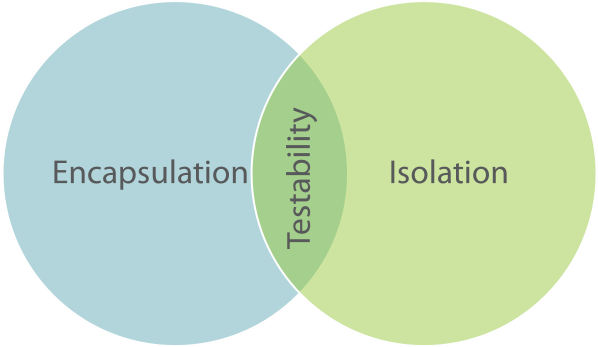
You can do TDD with Object-Oriented Programming, and as long as you stay within the intersection of Encapsulation and Isolation, you may be able to stay clear of test-induced damage. However, that zone of testability isn't particularly big, so it's easy to stray. You have to be very careful and know what you're doing. Not surprisingly, many books and articles have been written about TDD, including quite a few on this blog.
The best of both worlds #
In Functional Programming, on the other hand, Isolation is the ideal. An ideal function is already isolated from its dependencies, so no more design work is required to make it testable.
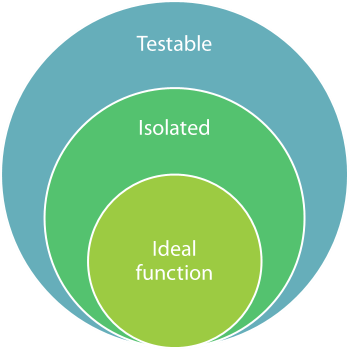
Ideal Functional design is not only ideal, but also perfectly testable, so there's no conflict. This is the underlying reason that TDD doesn't lead to test-induced damage with Functional Programming.
Summary #
Isolation is an important quality of Functional Programming. An ideal function is Isolated, and that means that it's intrinsically testable. You don't have to tweak any design principles in order to make a function testable - in fact, if a function isn't testable, it's a sign that it's poorly designed. Thus, TDD doesn't lead to Test-Induced Damage in Functional Programming.
If you want to learn more about this, as well as see lots of code examples, you can watch my Test-Driven Development with F# Pluralsight course.
Test-Driven Development with F# Pluralsight course
Test-Driven Development and Functional Programming is a match made in heaven. Learn how and why in my new Pluralsight course.
A common criticism against Test-Driven Development (TDD) is that it leads to Test-Induced Damage. However, it doesn't have to be that way, and it turns out that with Functional Programming (FP), the design ideals of FP coincide with TDD.
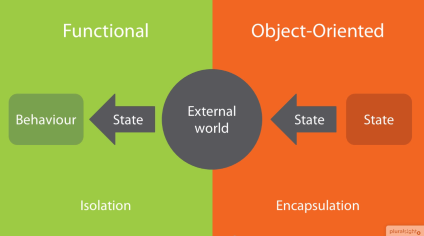
In my new Pluralsight course on Test-Driven Development with F#, you'll learn how the intersection between TDD and F# presents opportunities for better design and better testability.
Introduction to Property based Testing with F# Pluralsight course
My latest Pluralsight course is an introduction to Property-Based Testing with F#.
Soon after the release of my Unit Testing with F# Pluralsight course, it gives me great pleasure to announce my new course, which is an Introduction to Property-based Testing with F#.
In this course, you'll get an introduction to the concept of Property-Based Testing, and see a comprehensive example that demonstrates how to incrementally implement a feature that otherwise would have been hard to address in an iterative fashion.
C# will eventually get all F# features, right?
C# will never get the important features that F# has. Here's why.
The relationship between C# and F# is interesting, no matter if you look at it from the C# or the F# perspective:
- Before releasing F# to the world, Don Syme, its inventor, was instrumental in getting generics into C# and .NET. Had it not been for his and his Cambridge colleagues' effort, we wouldn't have generics today, or we would have the subpar generics that Java has. (Okay, so this point isn't strictly about F#.)
- F# has had async workflows since 2007. In F#, this is simply one of many implementations of a more general language feature called Computation Expressions - other common examples are Sequence Expressions and Query Expressions, but you can also create your own. When async/await was added to C# in 2012, it was a port of that particular implementation, but turned into a one-shot language feature.
- C# 6 gets a lot of small language features, some of which F# already has: auto-property initializers, exception filters, expression-bodied function members...
- For C# 7, the design team is considering many Functional language features that F# already has: pattern matching, records, immutability, tuples...
It's not some hidden cabal that I'm trying to expose, either. Mads Torgersen has been quite open about this relationship.
Why care about F#, then? #
A common reaction to all of this seems to be that if C# eventually gets all the best F# features, there's no reason to care about F#. Just stick with C#, and get those features in the future.
The most obvious answer to such statements is that F# already has those features, while you'll have to wait for a long time to get them in C#. While C# 6 gets a few features, they are hardly killer features. So perhaps you'll get the good F# features in C#, but they could be years away, and some features might be postponed to later versions again.
In my experience, that argument mostly falls on deaf ears. Many programmers are content to wait, perhaps because they feel that the language choice is out of their hands anyway.
What F# features could C# get? #
Often, when F# enthusiasts attempt to sell the language to other programmers, they have a long list of language features that F# has, and that (e.g.) C# doesn't have. However, in the future, C# could hypothetically have those features too:
- Records. C# could have those as well, and they're being considered for C# 7. Implementation-wise, F# records compile to immutable classes anyway.
- Discriminated Unions. Nothing in principle prevents C# from getting those. After all, F# Discriminated Unions compile to a class hierarchy.
- Pattern matching Also being considered for C# 7.
- No nulls. It's a common myth that F# doesn't have nulls. It does. It's even a keyword. It's true that F# doesn't allow its Functional data types (records, unions, tuples, etc.) to have null values, but it's only a compiler trick. At run-time, these types can have null values too, and you can provide null values via Reflection. C# could get such a compiler trick as well.
- Immutability. F#'s immutability 'feature' is similar to how it deals with nulls. Lots of F# can be mutable (everything that interacts with C# code), but the special Functional data types can't. Again, it's mostly in how these specific data types are implemented under the hood that provides this feature, and C# could get that as well.
- Options. These are really just specialised Discriminated Unions, so C# could get those too.
- Object Expressions. Java has had those for years, so there's no reason C# couldn't get them as well.
- Partial Function Application. You can already do this in C# today, but the syntax for it is really awkward. Thus, there's no technical reason C# can't have that, but the C# language designers would have to come up with a better syntax.
- Scripting. F# is great for scripting, but as the success of scriptcs has shown, nothing prevents C# from being a scripting language either.
- REPL. A REPL is a really nice tool, but scriptcs already comes with a REPL, again demonstrating that C# could have that too.
What F# features can C# never get? #
There are a few F# features that many people point to as their favourite, that C# is unlikely to get. A couple of them are:
- Type Providers. Someone that I completely trust on this issue told me quite authoritatively that "C# will never get Type Providers", and then laughed quietly. While I don't know enough about the technical details of Type Providers to be able to evaluate that statement, I trust this person completely on this issue.
- Units of Measure. Here, I simply have to confess ignorance. While I haven't seen talk about units of measure for C#, I have no idea whether it's doable or not.
In a recent article, I explained how less is more when it comes to language features. Many languages come with redundant features (often for historical reasons), but the fewer redundant features a language has, the better.
The F# compiler doesn't allow circular dependencies. You can't use a type or a function before you've defined it. This may seem like a restriction, but is perhaps the most important quality of F#. Cyclic dependencies are closely correlated with coupling, and coupling is the deadliest maintainability killer of code bases.
In C# and most other languages, you can define dependency cycles, and the compiler makes it easy for you. In F#, the compiler makes it impossible.
Studies show that F# projects have fewer and smaller cycles, and that there are types of cycles (motifs) you don't see at all in F# code bases.
The F# compiler protects you from making cycles. C# will never be able to do that, because it would be a massive breaking change: if the C# compiler was changed to protect you as well, most existing C# code wouldn't be able to compile.
Microsoft has never been in the habit of introducing breaking changes, so I'm quite convinced that this will never happen.
Summary #
C# could, theoretically, get a lot of the features that F# has, but not the 'feature' that really matters: protection against coupling. Since coupling is one of the most common reasons for code rot, this is one of the most compelling reasons to switch to F# today.
F# is a great language, not only because of the features it has, but even more so because if the undesirable traits it doesn't have.
Comments
I would say C# won't get non-nullable reference types either, even in the form of a compiler trick. It would either introduce too much of breaking changes or be very limited and thus not especially usefull.
Vladimir, thank you for writing. You're probably correct. Many years ago, I overheard Anders Hejlsberg say that it wouldn't be possible to introduce non-nullable reference types into the .NET platform without massive breaking changes. I can't say I ever understood the reasoning behind this (nor was it ever explained to me), but when Anders Hejlsberg tells you that, you sort of have to accept it :)
FWIW, there's a bit of discussion about non-nullable reference types in the C# Design Meeting Notes for Jan 21, 2015, but I have to admit that I didn't follow the link to Eric Lippert's blog :$
Less is more: language features
Many languages have redundant features; progress in language design includes removing those features.
(This post is also available in Japanese.)
There are many programming languages, and new ones are being introduced all the time. Are these languages better than previous languages? Obviously, that's impossible to answer, since there's no clear measurement of what constitutes a 'better' programming language.
Still, if you look at a historical trend, it looks as though one way to make a better language is to identify a redundant language feature, and design a new language that doesn't have that feature.
"perfection is attained not when there is nothing more to add, but when there is nothing more to remove." - Antoine de Saint Exupéry
In this article, you'll see various examples of language features that have already proven to be redundant, and other features where we are seeing strong indications that they are redundant.
Limitless ways to shoot yourself in the foot. #
When the first computers were created, programs had to be written in machine code or assembly language. In machine code, you can express everything the CPU can do, because the machine code is written it terms of a CPU's instruction set. While it's possible to write correct programs in machine code, you can also write a lot of incorrect programs, including programs that crash horribly, or perhaps even destroy the machine on which they are running.
You're most likely used to writing code in a higher-level language, but even so, if you share my experience with this, you'll agree that it takes a lot of trial and error to get things right. For every correct program, there are many incorrect variations. The set of incorrect programs is much bigger than the set of correct programs.
With machine code, you have limitless ways to create incorrect programs. Yes: you can express everything the CPU can execute, but most of it will be incorrect. Thus, the set of valid programs is a small subset of the set of all possible instructions.

Early computer programmers quickly discovered that writing in machine code was extremely error-prone, and the code was also as unreadable as it could be. One way to address this problem was to introduce assembly language, but it didn't solve the underlying problems: most assembly languages were just 'human-readable' one-to-one mappings over machine code, so you still have unlimited ways to express incorrect programs.
High-level languages #
After having suffered with machine code and assembly language for some time, programmers figured out how to express programs in high-level languages. The first programming languages aren't in much use today, but a good example of a 'low-level' high-level language still in use today is C.

In C, you can express almost all valid programs. There are still tons of ways to write incorrect programs that will crash the program (or the computer), but since the language is an abstraction over machine code, there are instructions you can't express. Most of these are invalid instruction sequences anyway, so it's for the better.
Notice what happened: moving from machine code to a high-level programming language removes a feature of the language. In machine code, you can express anything; in a high-level language, there are things you can't express. You're okay with that, because the options that were taken away from you were bad for you.
GOTO #
In 1968, Edsger Dijkstra published his (in)famous paper Go To Statement Considered Harmful. In it, he argued that the GOTO statement was an bad idea, and that programs would be 'better' without the GOTO statement. This sparked a decade-long controversy, but these days we've come to understand that Dijkstra was right. Some of the most popular languages in use today (e.g. Java and JavaScript) don't have GOTO at all.

Since GOTO has turned out to be an entirely redundant language feature, a language without it doesn't limit your ability to express valid programs, but it does limit your ability to express invalid programs.
Do you notice a pattern?
Take something away, and make an improvement.
There's nothing new about this; Robert C. Martin told us that years ago.
You can't just arbitrarily take away anything, because that may constrain you in such a way that there are valid programs you can no longer write:

You have to take away the right features.
Exceptions #
Today, everyone seems to agree that errors should be handled via some sort of exception mechanisms; at least, everyone can agree that error codes are not the way to go (and I agree). We need something richer than error codes, and something that balances usefulness with robustness.
The problem with exceptions is that this mechanism is really only GOTO statements in disguise - and we've already learned that GOTO is considered harmful.
A better approach is to use a sum type to indicate either success or failure in a composable form.
Pointers #
As Robert C. Martin also pointed out, in older languages, including C and C++, you can manipulate pointers, but as soon as you introduce polymorphism, you no longer need 'raw' pointers. Java doesn't have pointers; JavaScript doesn't do pointers; C# does allow you to use pointers, but I've personally never needed them outside of interop with the Windows API.
As these languages have demonstrated, you don't need access to pointers in order to be able to pass values by reference. Pointers can be abstracted away.
Numbers #
Most strongly typed languages give you an opportunity to choose between various different number types: bytes, 16-bit integers, 32-bit integers, 32-bit unsigned integers, single precision floating point numbers, etc. That made sense in the 1950s, but is rarely important these days; we waste time worrying about the micro-optimization it is to pick the right number type, while we lose sight of the bigger picture. As Douglas Crockford explains, in JavaScript there's only a single number type, which is a great idea - just too bad it's the wrong single number type.

With the modern computer resources we have today, a programming language that would restrict you to a single, sane number type would be superior to the mess we have today.
Null pointers #
Nulls are one of the most misunderstood language constructs. There's nothing wrong with the concept of a value that may or may not be present. Many great programming languages have this concept. In Haskell, it's called Maybe; in F#, it's called option; in T-SQL it's called null. What's common in all these languages is that it's an opt-in language feature: you can declare a value as being 'nullable', but by default, it isn't (nullable).
However, due to Tony Hoare's self-admitted billion-dollar mistake, mainstream languages have null pointers: C, C++, Java, C#. The problem isn't the concept of 'null', but rather that everything can be null, which makes it impossible to distinguish between the cases where null is an appropriate and expected value, from the cases where null is a defect.
Design a language without null pointers, and you take away the ability to produce null pointer exceptions.
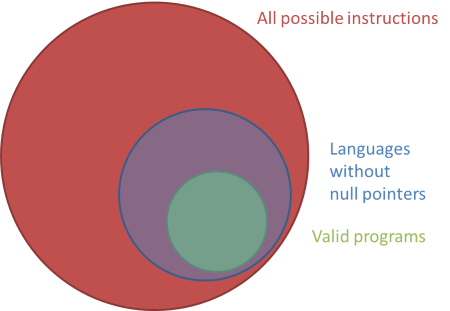
If Tony Hoare is correct that null pointers cost billions of dollars in the last few decades, getting rid of that source of defects can save you lots of money. From Turing-complete languages like T-SQL, Haskell, and F# we know that you can express all valid programs without null pointers, while a huge source of defects is removed.
Mutation #
A central concept in Procedural, Imperative, and Object-Oriented languages is that you can change the value of a variable while executing your program. That's the reason it's called a variable. This seems intuitive, since a CPU contains registers, and what you actually do when you execute a program is that you move values in and out of those registers. It's also intuitive because the purpose of most programs is to change the state of the world: Store a record in a database. Send an email. Repaint the screen. Print a document. Etc.
However, it turns out that mutation is also a large source of defects in software, because it makes it much harder to reason about code. Consider a line of C# code like this:
var r = this.mapper.Map(rendition);
When the Map method returns, has rendition been modified? Well, if you follow Command Query Separation, it shouldn't, but the only way you can be sure is to review the implementation of the Map method. What if that method exhibits the same problem, by calling into other methods that could mutate the state of the application? There's nothing in C# (or Java, or JavaScript, etc.) that prevents this from happening.
In a complicated program with a big call stack, it's impossible to reason about the code, because everything could mutate, and once you have tens or hundreds of variables in play, you can no longer keep track of them. Did the isDirty flag change? Where? What about the customerStatus?
Imagine taking away the ability to mutate state:
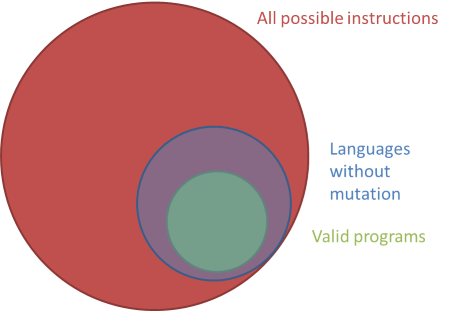
Most languages don't completely take away this ability, but as Haskell (a Turing complete language) demonstrates, it's possible to write any program without implicit state mutation.
At this point, many people might object that Haskell is too difficult and unintuitive, but to me, that kind of argumentation is reminiscent of the resistance to removing GOTO. If you are used to relying on GOTO, you have to learn alternative ways to model the same behaviour without GOTO. Likewise, if you are used to relying on state mutation, you have to learn alternative ways to model the same behaviour without state mutation.
Reference Equality #
In Object-Oriented languages like C# and Java, the default equality comparison is Reference Equality. If two variables point to the same memory address, the variables are considered equal. If two variables have all identical constituent values, but point to two different memory addresses, they are considered different. That's not intuitive, and many software defects are caused by this.
What if you take away Reference Equality from a language?
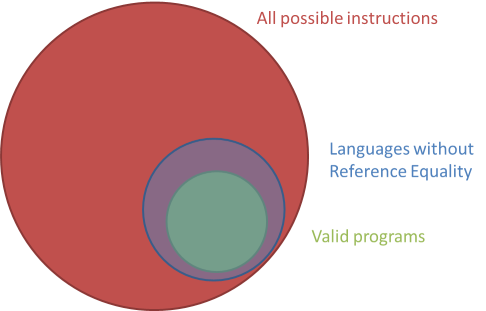
What if all data structures instead had Structural Equality?
This one I'm not entirely sure about, but in my experience, I almost never need Reference Equality. For Basic Correctness you never need it, but I wonder if you may need the occasional reference comparison in order to implement some performance optimizations... Still, it wouldn't hurt to switch the defaults so that Structural Equality was the default, and there was a special function you could invoke to compare two variables for Reference Equality.
Inheritance #
Even in 2015, inheritance is everywhere, although it's more than 20 years ago the Gang of Four taught us to favor object composition over class inheritance. It turns out that there's nothing you can do with inheritance that you can't also do with composition with interfaces. The converse doesn't hold in languages with single inheritance: there are things you can do with interfaces (such as implement more than one), that you can't do with inheritance. Composition is a superset of inheritance.
This isn't just theory: in my experience, I've been able to avoid inheritance in the way I've designed my code for many years. Once you get the hang of it, it's not even difficult.
Interfaces #
Many strongly typed languages (for example Java and C#) have interfaces, which is a mechanism to implement polymorphism. In this way, you can bundle various operations together as methods on an interface. However, one of the consequences of SOLID is that you should favour Role Interfaces over Header Interfaces, and as I've previously explained, the logical conclusion is that all interfaces should only have a single member.
When interfaces only have a single member, the interface declaration itself tends to mostly be in the way - the only thing that matters is the operation. In C#, you could just use a delegate instead, and even Java has lambdas now.
There's nothing new about this. Functional languages have used functions as the basic compositional unit for years.
In my experience, you can model everything with single-member interfaces, which also implies that you can model everything with functions. Again, this isn't really surprising, since functional languages like Haskell are Turing complete too.
It's possible to get by without interfaces. In fact, Robert C. Martin finds them harmful.
Reflection #
If you've ever done any sort of meta-programming in .NET or Java, you probably know what Reflection is. It's a set of APIs and language or platform features that enable you to inspect, query, manipulate, or emit code.
Meta-programming is an indispensable tool, so I'd be sorry to lose it. However, Reflection isn't the only way to enable meta-programming. Some languages are homoiconic, which means that a program in such languages is structured as data, which itself can be queried and manipulated like any other data. Such languages don't need Reflection as a feature, because meta-programming is baked into the language, so to speak.
In other words: Reflection is a language feature aimed at the goal of meta-programming. If meta-programming can be achieved via homoiconicity instead, it would imply that Reflection is a redundant feature.
Cyclic Dependencies #
While it may be true that null pointers are the biggest single source of software defects, in my experience the greatest single source of unmaintainable code is coupling. One of the most problematic types of coupling is cyclic dependencies. In languages like C# and Java, cyclic dependencies are almost impossible to avoid.
Here's one of my own mistakes that I only discovered because I started to look for it: in the otherwise nice and maintainable AtomEventStore, there's an interface called IXmlWritable:
public interface IXmlWritable { void WriteTo(XmlWriter xmlWriter, IContentSerializer serializer); }
As you can tell, the WriteTo method takes an IContentSerializer argument.
public interface IContentSerializer { void Serialize(XmlWriter xmlWriter, object value); XmlAtomContent Deserialize(XmlReader xmlReader); }
Notice that the Deserialize method returns an XmlAtomContent value. How is XmlAtomContent defined? Like this:
public class XmlAtomContent : IXmlWritable
Notice that it implements IXmlWritable. Oh, dear!
Although I'm constantly on the lookout for these kinds of things, that one slipped right past me.
In F# (and, I believe, OCaml), on the other hand, this wouldn't even have compiled!
While F# has a way to introduce small cycles within a module using the and and rec keywords, there are no accidental cycles. You have to explicitly use those keywords to enable limited cycles - and there's no way to define cycles that span modules or libraries.
What an excellent protection against tightly coupled code! Take away the ability to (inadvertently) introduce Cyclic Dependencies, and get a better language!

This has even been shown to work in the wild: Scott Wlaschin examined C# and F# projects for cycles, and found that F# projects have fewer and smaller cycles than C# projects. This analysis was later enhanced and corroborated by Evelina Gabasova.
Summary #
What I've tried to illustrate in this article is that there are many ways in which you could make a better language by taking away a particular feature from an existing language. Take away a redundant feature, and you'll still have a Turing complete language that can do (close to) anything, but with fewer options for shooting yourself in the foot.
Perhaps the ultimate programming language is a language without:
- GOTO
- Exceptions
- Pointers
- Lots of specialized number types
- Null pointers
- Mutation
- Reference equality
- Inheritance
- Interfaces
- Reflection
- Cyclic dependencies
Have I identified all possible redundant features? Most likely not, so here's a great opportunity for language designers to define an even better language, by finding something new to take away!
Update September 14 2015: This article sparked a .NET Rocks! episode with even more discussion about this topic.
Comments
The idea that Javascript is a superset of "valid programs", but that C is not, could do with more explanation.
My background is in server code (Haskell/Java/Python/Javascript/Rust), web code (Javascript) and embedded code (Rust/C) (with some ARM assembly for when Rust/C can't produce the needed program unaided). This makes the idea that I could express programs in Javascript, which I couldn't in C, very interesting.
I think that Rust is going to be very important in embedded development, in a few years.
P.S. I hope I have commented in the correct way.
Chris, thank you for writing. Where in this article do I claim that there are programs you could express in JavaScript, but not in C?
Thanks for the post Mark. Some great points; I like especially the idea of disallowing cyclic dependencies. That'd be awesome on a legacy Java project I'm working on now!
Having working in Scala and a little Haskell, I can say I love the Maybe type. One thing I have trouble visualising still is Exceptions. I think I need to find some more examples on doing without exceptions in real applications.
I guess there's somewhat of a middle ground between having the "safest" language, vs the most performant language. In a lot of cases you don't need awesome performance so the safest language is the better one... but in some you do. You occasionally need control over how your bits are packed.
Let's hope for the future!
Lachlan, thank you for writing. When it comes to working without exceptions, the point is to replace them with something stronger. Scott Wlashin's post and presentation about Railway Oriented Programming is a great place to start. You can see another example in my No Mocks presentation, and in one of my up-coming Pluralsight courses.
When it comes to the balance between safe and performant, there will always be room for languages that sacrifice safety for speed, but in my experience, this shouldn't be a common concern. As soon as you're doing any sort of significant I/O, the cost of that tends to be so much higher than any potential imperfections in pure CPU processing.
Apart from that, I don't see why, in principle, a safe language couldn't also be performant. These two traits don't seem to me to be intrinsically mutually exclusive.
As one of less-is-more advocates, I feel your article makes sense instinctively. However, one thing keeps bugging me:
I think I know what you try to mean with it, but once we try to be more specific, validity can only be defined in terms of a certain framework of semantics. If we have such a framework, then we can derive a programming language from it, which would be a language that only accepts valid programs and reject others. Problem solved.
In reality we don't have such a framework. We don't know what is a valid program precisely. There are programs that doesn't seem to make sense, and there are programs that are obviously useful, but there are huge gray area inbetween. It's actually a moving target---the context, the environment, the user, and other outside factors will greatly affect what's valid or not. But the fact that we don't know what valid programs shakes the ground of this whole discussion, doesn't it? Or it can end up tautology---"valid programs are defined in terms of this language, so this language fit the best to cover the valid programs."
Shiro Kawai, thank you for writing. In this article, I deliberately left the definition of validity vague. Why do we write software? If we exclude Katas and the like (which we do for training), software is ultimately written in order to solve problems; in order to be used. A valid program is a program that's useful.
This doesn't change the discussion, which is pragmatic. From experience, we know that we don't need GOTO; from experience, we know that we don't need pointers; from experience, we know that we don't need null pointers; from experience, we know that we don't need inheritance; etc.
Hi, thanks for the reply. I believe I get your intent. What I wanted was to point out a danger of this kind of argument. Because when you write software to solve problems, you need to articulate the problem, and the way you frame the problem is inevitably influenced by the frame of your language of choice. In other words, when you think you tighten the circle of the language features, it's not necessarily that you get it close to supposed set of "valid programs", but you may just as well start ignoring useful programs outside of your langauge circle and you don't even realize that. You just think "ok, there may be some programs that falls outside but it's not that important." How do you verify that the excluded gray area isn't that important?
(I wrote "you", but actually this is something I constanly try to remind myself, since I tend to be dragged toward feature-minimalism. I love Scheme.)
For example, you talk single-member inheritance and you brought up Haskell, but you didn't mention type classes. Isn't type classe sort of interface, in a sense that it defines a protocol consists of multiple functions? Do you say it's actually redundant? Or will you dismiss programs that can be expressed well using type classes "unimportant"?
Another controversial (and probably obscure) feature is change-class in CL. This one is such a beast that it's difficult to cope with many modern features (obviously it invalidates strict typecheckers). However, in the context where the feature is needed, I don't know if there's a replacement. If you get rid of it, you just have to give up the kind of software that require the feature. That's a reasonable trade-off, but what you do is that you cut off a part of "valid programs" in order to tighten the circle.
There's no solid circle of valid programs, and as you tighten the circle of the language, you actually shape the circle of valid programs that suit to the circle of language you draw. That's not necessarily a bad thing, but the language designers need to be aware of it, that's what I wanted to say.
It's a good point that a language shapes how you approach problems. In this discussion, I assume that all languages (both existing and hypothetical) are Turing complete, but even under that assumption, there will be problems that are difficult, or perhaps even impossible, to address in a particular language.
The question is whether that isn't true for all languages?
In a sense, the most 'powerful' languages are all the dialects of machine code. By definition, they should be able to express everything a particular CPU can do, so by corollary, they should be the most complete languages available. Despite being complete, these dialects don't have inheritance, exceptions, Reflection, interfaces, or a lot of other things. Such features are features that have been added to some languages. Logically, I don't see how 'removing' such a feature constrains one's ability to express 'all valid programs'.
To be fair, that argument of mine doesn't apply to all the language features I've described. For example, CPU instruction sets most certainly allow immutability.
What I was aiming at with my article was never a formal discussion about how a hypothetical language would, or wouldn't, be able to express 'all valid programs'. The purpose was more to point out that decades of experience should by now have taught the overall programmer community that there are many language features that we can do without.
As I pointed out, you can't arbitrarily remove features. Some features are extremely important within a particular language, while it may be irrelevant in another language. While I don't know much about Type Classes, it seems to be an example of this: it's very important in Haskell, but doesn't exist at all in C# or F#.
This is also the reason why I don't think we'll ever have a single, perfect programming language. In the future, we'll also have many different languages, and they'll be good at different types of problems.
Just as it is today, it'll be important to know more than a single programming language, because, exactly as you wrote, a problem may 'fall outside' a given language, but then, if you know another language, you may realise that you can use it to solve that particular problem.
Unit Testing with F# Pluralsight course
My latest Pluralsight course is an introduction to unit testing with F#.
Perhaps you already know all about unit testing. Perhaps you already know all about F#. But do you know how to write unit tests in F#?

My new Pluralsight course explains how to write unit tests with F#. If you already know F# and unit testing on .NET, it's quite straightforward. This is my first beginner-level course on Pluralsight, so regular readers of this blog may find it too basic.
Still, if you don't know what Unquote is and can do for you, you may want to consider watching module four, which introduces this great assertion library, and provides many examples.
This entire course will, together with some of my existing Pluralsight courses, serve as a basis for more courses on F# and Test-Driven Development.
POSTing JSON to an F# Web API
How to write an ASP.NET Web API service that accepts JSON in F#.
It seems that many people have problems with accepting JSON as input to a POST method when they attempt to implement an ASP.NET Web API service in F#.
It's really quite easy, with one weird trick :)
You can follow my recipe for creating a pure F# Web API project to get started. Then, you'll need to add a Data Transfer Record and a Controller to accept your data:
[<CLIMutable>] type MyData = { MyText : string; MyNumber : int } type MyController() = inherit ApiController() member this.Post(myData : MyData) = this.Ok myData
That's quite easy; there's only one problem with this: the incoming myData value is always null.
The weird trick #
In addition to routes etc. you'll need to add this to your Web API configuration:
GlobalConfiguration.Configuration.Formatters.JsonFormatter.SerializerSettings.ContractResolver <- Newtonsoft.Json.Serialization.CamelCasePropertyNamesContractResolver()
You add this in your Application_Start method in your Global class, so you only have to add it once for your entire project.
The explanation #
Why does this work? Part of the reason is that when you add the [<CLIMutable>] attribute to your record, it causes the record type to be compiled with auto-generated internal mutable fields, and these are named by appending an @ character - in this case, the field names become MyText@ and MyNumber@.
Apparently, the default JSON Contract Resolver (whatever that is) goes for those fields, even though they're internal, but the CamelCasePropertyNamesContractResolver doesn't. It goes for the properly named MyText and MyNumber writeable public properties that the compiler also generates.
As the name implies, the CamelCasePropertyNamesContractResolver converts the names to camel case, so that the JSON properties become myText and myNumber instead, but I only find this appropriate anyway, since this is the convention for JSON.
Example HTTP interaction #
You can now start your service and make a POST request against it:
POST http://localhost:49378/my HTTP/1.1
Content-Type: application/json
{
"myText": "ploeh",
"myNumber": 42
}
This request creates this response:
HTTP/1.1 200 OK
Content-Type: application/json; charset=utf-8
{"myText":"ploeh","myNumber":42}
That's all there is to it.
You can also receive XML instead of JSON using a similar trick.
Comments
[<JsonObject(MemberSerialization=MemberSerialization.OptOut)>] to the type also worksProperty Based Testing without a Property Based Testing framework
Sometimes, you don't need a Property-Based Testing framework to do Property-Based Testing.
In my previous post, I showed you how to configure FsCheck so that it creates char values exclusively from the list of the upper-case letters A-Z. This is because the only valid input for the Diamond kata is the set of these letters.
By default, FsCheck generates 100 random values for each property, and runs each property with those 100 values. My kata code has 9 properties, so that means 900 function calls (taking just over 1 second on my Lenovo X1 Carbon).
However, why would we want to select 100 random values from a set of 26 valid values? Why not simply invoke each property (which is a function) with those 26 values?
That's not so hard to do, but if there's a way to do it with FsCheck, I haven't figured it out yet. It's fairly easy to do with xUnit.net, though.
What you'll need to do is to change the Letters type to an instance class implementing seq<obj[]> (IEnumerable<object[]> for the single C# reader still reading):
type Letters () = let letters = seq {'A' .. 'Z'} |> Seq.cast<obj> |> Seq.map (fun x -> [|x|]) interface seq<obj[]> with member this.GetEnumerator () = letters.GetEnumerator() member this.GetEnumerator () = letters.GetEnumerator() :> Collections.IEnumerator
This is simply a class that enumerates the char values 'A' to 'Z' in ascending order.
You can now use xUnit.net's Theory and ClassData attributes to make each Property execute exactly 26 times - one for each letter:
[<Theory; ClassData(typeof<Letters>)>] let ``Diamond is as wide as it's high`` (letter : char) = let actual = Diamond.make letter let rows = split actual let expected = rows.Length test <@ rows |> Array.forall (fun x -> x.Length = expected) @>
Instead of 900 tests executing in just over 1 second, I now have 234 tests executing in just under 1 second. A marvellous speed improvement, and, in general, a triumph for mankind.
The point is that if the set of valid input values (the domain) is small enough, you may consider simply using all of them, in which case you don't need a Property-Based Testing framework. However, I still think this is probably a rare occurrence, so I'll most likely reach for FsCheck again next time I need to write some tests.
A simpler Arbitrary for the Diamond kata
There's a simple way to make FsCheck generate letters in a particular range.
In my post about the Diamond kata with FsCheck, I changed the way FsCheck generates char values, using this custom Arbitrary (essentially a random value generator):
type Letters = static member Char() = Arb.Default.Char() |> Arb.filter (fun c -> 'A' <= c && c <= 'Z')
This uses the default, built-in Arbitrary for char values, but filters its values so that most of them are thrown away, and only the letters 'A'-'Z' are left. This works, but isn't particularly efficient. Why generate a lot of values only to throw them away?
It's also possible to instruct FsCheck to generate values from a particular set of valid values, which seems like an appropriate action to take here:
type Letters = static member Char() = Gen.elements ['A' .. 'Z'] |> Arb.fromGen
Instead of using Arb.Default.Char() and filtering the values generated by it, this implementation uses Gen.elements to create a Generator of the values 'A'-'Z', and then an Arbitrary from that Generator.
Much simpler, but now it's also clear that this custom Arbitrary will be used to generate 100 test cases (for each property) from a set of 26 values; that doesn't seem right...
Library Bundle Facade
Some people want to define a Facade for a bundle of libraries. Is that a good idea?
My recent article on Composition Root reuse generated some comments:
These comments are from two different people, but they provide a decent summary of the concerns being voiced."What do you think about pushing these factories and builders to a library so that they can be reused by different composition roots?"
"We want to share the composition root, because otherwise when a component needs a new dependency and a constructor parameter is added, we'd have to change the same code in two different places."
Is it a good idea to provide one or more Facades, for example in the form of Factories or Builders, for the libraries making up a Composition Root? More specifically, is it a good idea to provide a Factory or Builder that can compose a complete object graph spanning multiple libraries?
In this article, I will attempt to answer that question for various cases of library bundles. To make the terminology a bit more streamlined, I'll refer to any Factory or Builder that composes object graphs as a Composer.
Single library #
In the case of a single library, I think I've already answered the question in the affirmative. There's nothing wrong with including a Facade in the form of a Factory or Builder in order to make that single library easier to use.
Two libraries #
When you introduce a second library, things start becoming interesting. If we consider the case of two libraries, for example a Domain Model and a Data Access Library, the Composition Root will need to compose an object graph where some of the objects in the graph are from the Domain Model, and some of the objects are from the Data Access Library.

In the spirit of Agile Principles, Patterns, and Practices (APPP), it turns out that simply drawing dependency diagrams can be helpful. From the Dependency Inversion Principle (DIP) we know that the "clients [...] own the abstract interfaces" (APPP, chapter 11), which means that for our two example libraries, the dependency graph must look like this:
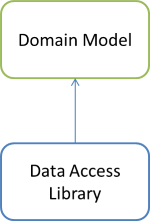
At least, if you follow the most common architectures for loosely couple code, the Domain Model is the 'client', so it gets to define the interfaces it needs. Thus, it follows that the Data Access Library, in order to implement those interfaces, must have a compile-time dependency on the Domain Model. That's what the arrow means.
From this diagram, it should be clear that you can't put a Factory or Builder in the Domain Model library. If the Composer should compose object graphs from both libraries, it would need to reference both of those libraries, and the Domain Model can't reference the Data Access Library, since that would result in a circular reference.
You could put the Composer in the Data Access Library, but that somehow doesn't feel right, and in any case, as we shall see later, this solution can't be generalised to n libraries.
A solution that many people reach for, then, is to pull the interfaces out into a separate library, like this:
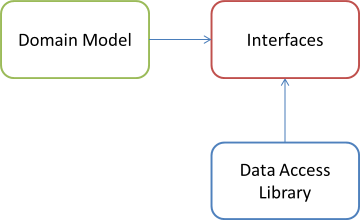
It's a bit like cheating, according to the DIP, but it's as decoupled as before. In this diagram, the Domain Model depends on the interfaces because it uses them, while the Data Access Library depends on the interface library because it implements the interfaces. Unfortunately, this doesn't solve the problem at all, because there's still no place to place a Composer without getting into a problem with either the DIP, or circular references (exercise: try it!).
A possible option is to keep the libraries as the DIP dictates, and then add a third Composer library:
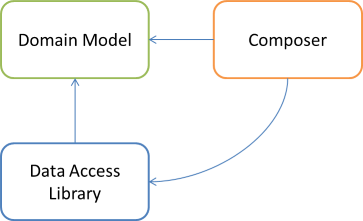
The Composer library references both the Domain Model and the Data Access Library, so it's possible for it to compose object graphs with objects from both libraries. The only purpose of this library, then, is to compose those object graphs, so it'll likely only contain a single class.
Multiple libraries #
Does the above conclusions change if you have more than two libraries? Only in the sense that it further restricts your options. As the analysis of the special case with two libraries demonstrated, you only have two options for adding a Composer to your bundle of libraries:
- Put the Composer in the Data Access Library
- Put the Composer in a new dedicated library
Imagine that you have two Data Access Libraries instead of one:
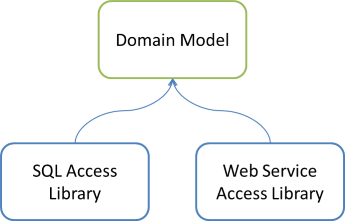
For instance, the SQL Access Library may implement various interfaces defined by the Domain Model, based on a SQL Server database; and the Web Service Access Library may implement some other interfaces by calling out to some web service.
If the Composer must be able to compose object graphs with object from all three libraries, it must reside in a library that references all of the relevant libraries. The Domain Model is still out of the question because you can't have circular references. That leaves one of the two Data Access libraries. It'd be technically possible to e.g. add a reference from the SQL Access Library to the Web Service Access Library, and put the Composer in the SQL Access Library:
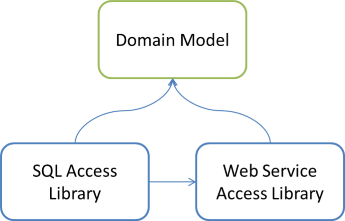
However, why would you ever do that? It's clearly wrong to let one Data Access library depend on another, and it doesn't help if you reverse the arrow.
Thus, the only option left is to add a new Composer library:
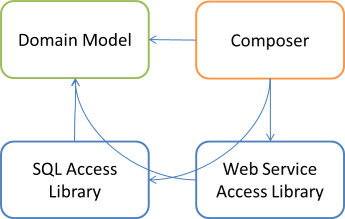
As before, the Composer library has references to all other libraries, and contains a single class that composes object graphs.
Over-engineering #
The point of this analysis is to arrive at the conclusion that no matter how you twist and turn, you'll have to add a completely new library with the only purpose of composing object graphs. Is it warranted?
If the only motivation for doing this is to avoid duplicated code, I would argue that this looks like over-engineering. In the questions quoted above, it sounds as if the Rule of Three isn't even satisfied. It's always important to question your motivations for avoiding duplication. In this case, I'd be wary of introducing so much extra complexity only in order to avoid writing the same lines of code twice - particularly when it's likely that the duplication is accidental.
TL;DR #
Attempting to provide a reusable Facade to compose object graphs across multiple libraries is hardly worth the trouble. Think twice before you do it.
Comments
Dear Mark,
Thanks again for another wonderful post. I'm one of the guys you mentioned at the beginning of this text and I totally agree with you on this subject.
Maybe I wasn't specific enough in my comment that I didn't mean to introduce factories and builders handling dependencies from two or more assemblies, but only from a single one. The composition root wires the independent subgraphs from the different assemblies together.
However, I want to reemphasize the Builder Pattern in this context: it provides default dependencies for the object graph to be created and (usually) a fluent API (i.e. some sort of method chaining) to exchange these dependencies. This has the following consequences for the client programmer using the builder(s): he or she can easily create a default object graph by calling new Builder().Build() and still exchange dependencies he or she cares about. This can keep the composition root clean (at least for Arrange phases of tests this is true).
Why I'm so excited about this? Because I use this all the time in my automated tests, but haven't really used it in my production composition roots (or seen it in others). After reading this post and Composition Root Reuse, I will try to incorporate builders more often in my production code.
Mark - thank you for making me think about this.
Kenny, thank you for writing. The Builder pattern is indeed a good way to implement Facades for a single library.

Comments
What do you mean by "value"? Can an exception instance be a value? More specifically, would you say that the C# function
int Foo() => new Exception();is pure?Many of your posts mention pure funcitons and at least a few of them include your own definition. I decided to comment on this post since it was the oldest post I found that included your own definition of a pure function.
Tyson, thank you for writing. I don't think that
int Foo() => new Exception();compiles...Apart from that, how do you find that this is my own definition of a pure function? It seems to me to be a standard and non-controversial definition. I even link to the Wikipedia definition in the beginning of the article.
I am not trying claim that any particular definition of a pure function is non-standard or is controversial. I also don't mean that the text I quoted is "your definition" in the sense that it semantically differs from the one on Wikipedia. I just mean that it is "your definition" in the sense that you have syntactically included in your post the text that I quoted.
However, I am unsure about the precise meaning the defintion for a pure function that you have syntactically included in your post and that I quoted. To help me improve my understanding of that defintion, I tried to ask you if a particular C# function is pure.
Ah, yes. Thanks for alerting me to my mistake. I meant to include the
throwskeyword as well. For clarity, I now repeat that whole paragraph but with the prose "thrown" and the keywordthrowsadded.What do you mean by "value"? Can a thrown exception instance be a value? More specifically, would you say that the C# function
int Foo() => throws new Exception();is pure?Tyson, your code still doesn't compile, but I think I understand the question 😜
Yes,
int Foo() => throw new Exception();is still a pure function, but it isn't total. Rather, it's a partial function. This is an independent quality of functions.Purity relates to determinism and the lack of side effects. A total function, on the other hand, is a function that returns a proper value for every possible value in its domain. What do I mean by proper?
There's two ways in which a function can fail to return a value. One is if the function never returns. Due to the halting problem there's no general-purpose way to determine whether or not this is the case for a Turing-complete language.
Another way a function can fail to return a value is if it throws an exception. Most languages (even Haskell!) allows exception-throwing. This isn't considered a 'proper' value because, using the type system, you declared that
Fooreturns anint. It doesn't. It 'returns' an exception.Both non-termination and exceptions are typically considered a special value termed bottom, often written with the symbol
⊥.Functions can be pure, but partial. Your
Foofunction is an example of that. The holy grail in statically typed functional programming is pure and total functions. It's up to the programmer to provide the totality guarantee, though, since the type system can't enforce termination (due to the halting problem). You can, on the other hand, easily program without exceptions once you get the hang of it.Thanks for seeing pass my second compile error and understanding my question.
Ah, yes. I definitely know about partial and total functions from my experience with mathematics, and I am pretty sure I have previously called a function that throws an exception partial, but I completely forgot about this connection. (I think that is because I have so focused on purity.) Thank you for bringing this concept (back) to my attention.
I was asking about pure functions and exception throwing because I was thinking about the definition for a pure function given by Enrico Buonanno in Functional Programming in C#. He considers throwing an exception a side effect and includes this paragraph about this decision.
What do you think about Enrico's choice to define exception throwing as a side effect?
It might be worth considering
async void Foo() => throw new Exception();because it produces an unhandled exception, which crashes the executing process.I haven't seen anyone take that position before, so I can only evaluate it based on what you wrote. With that limited context, however, I don't find the argument convincing. First, that throwing exceptions will cause indeterminism to appear in code that handles exceptions says nothing about the function that throws the exception. It says something about the code that handles the exception.
Making decisions based on data is itself not non-deterministic. If it was,
if/elseblocks or pattern matching couldn't be pure. If the exception handler does something impure while handling an exception, then it's just an impure action. The functional interaction law explicitly allows this.Keep in mind that the definition of purity that we're discussing is really only a checklist to figure out whether a function is referentially transparent. That's the core definition: Can you replace a function call with its result?
Yes, if the function is pure. This includes a function that throws an exception. It basically just returns
⊥. If you have code that handles the exception, it'll do that based on the exception that was thrown. It doesn't really matter if the function 'actually executed' or not. We can replace the function call with the bottom value.If you don't handle the exception, then yes: the program crashes. It'll do so, however, regardless of whether you 'run' the function, or you just replace it with a thrown exception.
Yes, this helps. I agree with you. Thanks for your explanation.
The respective problems of deciding if a given function is total or pure are equally difficult; both are undecidable by Rice's theorem. A compiler for Haskell is not a general-purpose algorithm for deciding the purity of a function. It follows from the syntax of Haskell that all functions in Haskell with a return type different from the IO monad are pure (and technically all the others as well). Rice's theorem doesn't apply when the property being checked is syntactic.
In the same way, it is possible to design a programming language with two contexts: one in which partial functions can be defined and another in which only total functions can be defined. As before, the partial function context could be expressed by the syntactic requirement that the return type is some monad.
I'm not familiar with Rice's theorem, so I'll have to take your word on that. Haskell, however, seems to be doing a fairly good job of distinguishing between pure and impure, but this could be because the impure actions ultimately aren't implemented in Haskell (IIRC, they're written in C or C++). This might be analogous to the following escape hatch for partiality versus totality.
You can't define a Turing-complete language where you generally distinguish between total and partial functions. That's what Turing, Gödel, and Church proved in the 1930's. The escape hatch is that if you define a language that's not Turing-complete, you can distinguish between total and partial functions. If I remember correctly, that's the underlying design philosophy of Idris. I believe that Edwin Brady once called the concept Pac-Man-complete; while not Turing-complete, he was aiming for a language powerful enough that you could still implement Pac Man in it. I do believe that Idris also comes with an option where you can escape into the wider, Turing-complete part of the language by giving up on the compiler checking of totality versus partiality.
Ah, great. Your comment motivated me to read more about Idris, and I have learned some things.
First, Idris includes a totality checker for functions. By default, a function is not checked for totality. Putting the keyword
totalabove a function defintion enables the checker. Here are some examples of this. The code then compiles if and only if the checker (which is essentially a theorem prover) is able to prove that the function is total. So the two contexts are distinguished by the presence or absence of the keywordtotal. This is a completely different approach to creating the two contexts than what I was vaguely suggesting.Second, Idris is Turing-complete as confirmed by Edwin Brady himself. Furthermore, both Edwin and this page about coinductive that he cites say (paraphrased into my words) that one could also separate the partial and total contexts using a monad. Though the linked page goes onto say that "this is a heavyweight solution, and so we would like to avoid it whenever possible."
I am really glad to have learned those things. Thanks for the great conversation :)
Would you say that
int Foo() { if (new Random().Next() % 2 == 0) throw new Exception(); else throw new NotImplementedException(); }is pure?No, that variation of
Foois impure because of the non-deterministic behaviour. You can't replace a call toFoowith a corresponding bottom value.Idris is very interesting. Have you seen attempts to test totality in other languages?
Spencer, thank you for writing. Usually, the names Agda and Coq are thrown around when Idris is mentioned. As far as I understand things, however, both Agda and Coq are mostly intended to be additional tools that you use together with another language, whereas the vision for Idris is to be a complete programming language. I could be wrong, though. It's a rabbit hole that I've yet to explore.
Another language worth mentioning might be F*, but again, I know little about it, and have never written a line of code in it.
Thank you for the leads! These languages are very interesting. I'd never heard of "proof-oriented programming" or depdendant types before. It's going to a take a while to unpack these new approaches.
I notice all these languages take a proof-based approach to verifying totality. I'm curious about your take on a possible experimental approach.
I've been trying to meld ideas from Clojure.spec into a type-driven approach in F#, in line with Scott Wlaschin's Designing with Types and your Types + Properties = Software. Clojure Spec, in case you're unfamiliar, is the Specification pattern as an optional type system. Types are built up through combinations of constraints (e.g. InventoryCount must be an int of at least 0 and no more than 10000). Spec can then automatically test type-annotated functions to verify that any input that fits constraints produces output that fits constraints. It's basically property testing with generators automatically created from the in-code type specifications.
I think this kind of testing is effectively a measure of totality; a measure of how well a function's actual domain matches its advertized domain. Clojure does not make that claim, and I haven't found a similar approach from another language or framework yet.
While less thorough than proofs, such a technique could be applied to most any system with static typing through meta-programming and conventions to find type constraints (i.e. via factory functions). The proportion of inputs that error or timeout could be a consistent measure for migrating systems to more total, and less surprising, functions.
Thoughts?
Spencer, thank you for writing. While I know that Clojure.spec exists, I don't know more about it than what you've described. It's not quite the same, but it sounds not too dissimilar from QuickCheck
Arbitraryinstances. They don't describe predicates, but they do implement (pseudo-random) generators of values. Those generators then drive data generation for property-based tests.Parametrised tests (including properties) are essentially predicates. They take input and return a binary result. Granted, the result isn't true or false, but rather pass or fail, but I hope it's evident that these are isomorphic.
How does that relate to testing totality? It's better than nothing, but in practice we must suffer the reality of combinatorics. You can easily use brute force to prove total a function that takes a single Boolean value as input. A byte input requires 256 test cases, so that's also within the realm of the possible. Many input types, however, represent conceptually infinite sets. A string, for example, represents a conceptually infinite set.
Imagine an adversarial function that loops forever if the input string is a very particular value. This value might be a one-million-character string generated randomly at compile time. The odds that any random test case generator ever hits that particular value are effectively nil.
While I like property-based testing a lot, I don't consider it a measure of totality. If the domain of a function is infinite, it makes little difference if you exercise a hundred or a million test cases - you've still covered practically zero percent of the domain.
You make an excellent point. If I understand correctly, many domains are effectively infinite so coverage of random testing is effectively negligable.
My connection to totality came from trying to understand what Clojure spec's instrument function is really testing. It's a property, but the property only knows the shape of the domain and range. It knows nothing about relationships between specific input and output values. Therefore, it doesn't verify business domain correctness. Rather, it's checking that the range holds true for a sampling of valid input values.
In light of your insight, it may be more fair to say this is a coverage "surprise" check. It can run common edge cases and input scenarios to make sure they return values from the advertized range rather than exceptions (or fail to terminate). As you discerned, it cannot generally detect adversarial implementations that would violate totality.
Thank you for taking the time to consider this idea and share your expertise!
Spencer, thank you for writing. If I understand your description of Clojure.spec correctly, this makes sense in a dynamically typed language like Clojure. It's seems reminiscent of fuzz testing in the sense that you throw arbitrary input at a System Under Test and then monitor what happens. This makes sense in a system where input is mostly (or exclusively) checked at run time.
In a language like Haskell, on the other hand, that kind of testing is generally impossible. You can't just throw random, unconstrained input at a Haskell function, because if the input doesn't type-check, the code will not even compile. Languages like C# and Java seem to fall more on that side than on the Clojure side, even though their types systems involve more ceremony.
To be clear: You could imagine something akin to a 'totality check' even in Haskell. After all, we know from the papers of Church, Gödel, and Turing that no type system can prove arbitrary Turing-complete code total (i.e. the halting problem). Even with the best-designed Haskell API, one might conceivably want to write a QuickCheck property that throws random (typed) input at a function only to assert that it returns a value. In essence, this would be an assertion-free test. The implicit assertion is that if the function returns without exceptions or timing out, then it may be total.
While one could do that, once you've gone through the trouble of writing such a property, you can often think of some sort of explicit assertion to write. If so, why not do that? But if you do, you've now ventured into the territory of genuine property-based testing. There's nothing wrong with that - quite the contrary - but I think it explains why you tend to not see the above kind of totality checking in statically typed languages.
Another point to consider is this: With a decent static type system (and I count C# in that category), you can often design APIs so that the types take care of most concerns regarding totality. It helps to realise that in most languages, functions can be partial in two ways:
You can usually eliminate the first kind of partiality by carefully choosing input and output types. Thus, in a statically typed language, you're often left with the question: Will this function always terminate?
While the halting problem says that there's no general algorithm that will answer that question, it's often obvious for specific functions. For instance, if a function has no recursion or looping, it obviously will terminate. This, to be clear, involves 'white-box' analysis. You have to look at the code and convince yourself that the function will terminate.
I've possibly strayed off your original agenda, but I found your comments and responses inspiring. I hope you or someone else find these notes useful.
I'm glad you've found this line of thought interesting! I've definitely enjoyed and benefitted from our discourse.
I agree this kind of testing bears a strong resemblance to fuzzing and that static types eliminate the majority of invalid inputs up front.
I'm going to dig deeper into my journey to see if it can explain why I think these tests are valuable.
It may not be clear, but the best thing about Clojure Spec's fuzz-like tests is that they don't have to be written at all. All type information is present in the type annotation, including primitive constraints like bounded integers. An introspective function can generically infer generators and assertions from type annotations to create the tests. All annotated functions get these fuzz tests for free.
In static languages, we get the structural component of these tests for free from the compiler. However, we're still missing out on verifying constrained values.
Approaches to combat primitive obsession go a long way toward eliminating such errors and defensive programming from our domains by centralizing validation and coupling it to a type.
Scott Wlaschin demonstrates constrained types using unions
More traditionally, it'd be a constructor
These approaches implement constrained types as a pattern rather than a language construct. A programmer could undermine them by forgetting to keep constructors private, adding new constructors, assigning via reflection, etc.
I spent a while trying to figure out how to add constrained values to F#'s types system and understand what it could do for us. It ultimately failed, but you can check out my attempts and my reasoning in the github repo. This was prior to me learning about dependent type systems, which are the more mature realization of my line of thought.
I later realized that the constraints don't need to be part of the type to be useful. The constraints are represented in the code as factories or constructors. The code itself will enforce the expectations at runtime. At test time it's ok to rely on slow introspective approaches to identify constraints. In that way, we too have all the information we need to mechanically property test a system just like clojure spec does. In fact, we can test every function in the system, intentionally constrained or not, because static languages require typing.
What do these tests do? Like with spec, we can derive some confidence that our system handles the values it says it does. Though not total certainty, which requires a white-box approach as you mentioned.
If a system is migrating from heavy use of exceptions for defensive programming, or from general lack of defensive programming, then this kind of test can track progress away from exceptions.
It can also help consistency of our constrained types. For example, we can always select the most weakly constrained factory or constructor. This prevents accidental public constructors (which, admittedly, could also be accomplished with an annotation and a simple analyzer). We can also pressure towards conventions like naming the factory a certain way, or only using results over exceptions for communicating errors from factories.
As a side benefit, we can also leverage the introspected generators to write our own properties. This reduces duplicated knowledge of constraints between the system and tests, keeping them in line automatically.
Thanks for reading this far. This is all pretty conceptual at this point. I hope it's fun food for thought.
A bit more rumination and I realized my thoughts above can be summarized in a few key points
- Clojure Spec tests I refer to aren't written, they're programmatically inferred from code
- Static languages encode all the information needed to programmatically generate and assert constrained value types like Clojure Spec, it's just that part of information lives in functions rather than types.
- Constrained values are effectively a design pattern in most static languages.
The language can't guarantee a consistent approach or consistent application, so there's value in adding natural pressures to be consistent.
It's kind of like how you once explained the value of DI containers
-
These tests can smoke out defensive programming issues and misadvertized function signatures.
This is only generalizable if we can differentiate expectable failures from unintended issues, thus why these tests mostly measure movement away from exceptions.
Please let me know if you'd like anything clarified. These are far from fully formed ideas.Spencer, thank you for writing. I already got the sense that the Clojure.spec tests weren't written, but thank you for confirming that. I don't know the implementation details of how that works, but I may have an inkling.
Clojure is, as I'm sure that you're aware, homoiconic. Thus, I suppose that the specs are written in Clojure as well. A function or macro can extract the details of each spec and generate test data that are likely to fit.
Consider, as a though experiement, a type like this:
If this was, instead, Clojure, then from perusing the Clojure.spec documentation it looks as though you'd use a predefined specification called
int-in, but even if you'd be using normal less-than and greater-than operators, I suppose it wouldn't be beyond the abilities of a sophisticated function to tease apart such a predicate and compose a useful generator.In languages like C#, F#, Java, or Haskell, however, predicates and types are typically black boxes. For the
Narrowsclass, you have a static factory method. This factory method is total, but if you throw random 64-bit integers at it, the chance of ever getting a populated Maybe value is vanishingly small.If you now have a function that takes that type as input, you can't really exercise it because of the statistics involved. This is why most property-based testing frameworks that I've seen (QuickCheck, Hedgehog, FsCheck, CsCheck) are based on a generator API (usually called either
ArbitraryorGen).While you can compose a type-specific generator from other generators, you have to explicitly do that work. The testing framework can't infer the set of valid values to use.
I'm not disagreeing with what you wrote. I'm only trying to outline how I see such efforts interact with the capabilities of various languages.
If I interpret this correctly, you're saying languages like C# and similar would have to throw random values at the Narrows TryCreate function to find instances. However, Clojure could use its macro system to understand the functions symbolically and semantically.
I think that languages like C# and F# can also semantically analyze code, but it has to be done through the compiler platforms (i.e. Roslyn, FSharp Compiler Services) or similar meta-programming. These are performance heavy, not every language has one, and only work when we have access to code, but they do make semantic analysis possible for functions.
We could use the compiler platform to parse constraints from factories. For example, analyze Narrows.TryCreate to find comparison operators, and that those comparisons lead to a "None" value. The other conditional branch is "Some", thus Narrows requres a long greater than 2_993_329_992 and less than 3_001_322_003. Then we use the inferred constraints to create typical property test generators and arbitraries.
However, I think your musing from a few posts back are now clicking better. You mused that static languages can effectively eliminate exception-based partiality through careful choice of types. I see two main categories of exceptions
This is really interesting. Thank you for pushing my thinking.
Spencer, thank you for writing. I didn't meant to imply that we should make a general-purpose code analyser - this seems to me to move perilously close to the halting problem; that is, I don't think you this is generally possible. (I could be wrong, though, I haven't thought deeply about this.)
What I meant was more that since Clojure.spec is written in Clojure, and Clojure code is also data, it's fairly easy to search a spec for easy-to-detect predicates. Something like a specification is fair game for analysis exactly because of the role it plays. I wouldn't contemplate analysing the function body of a Clojure function like that.
In .NET a typical approach to these kinds of problems is to use attributes. There's been quite a few attempts at that over the years - I've previously engaged with that kind of design, but in summary, I'm not a fan. It does, however, provide some metadata that's fair game for analysis.
The distinction, then, seems more related to the nature of the languages. With a language like C#, if you need metadata, it seems as though you need to invent a language feature for that purpose: attributes. In Clojure, on the other hand, because it's homoiconic, you don't need a separate language feature for metadata. You just write the metadata in Clojure. This doesn't, however, change the role of the spec. Even though you're writing it in Clojure, it plays the role of metadata. One of the implications of that is that it's fair game for an analyser, whereas I think a Clojure function body is still off limits for the Spec engine.
Ah, I misunderstood. I hadn't thought about the relationship between metadata and analyzers. Clojure certainly has the edge for elegant and powerful metadata.
I suppose I feel hope for analyzing function bodies for constraints in this context because type factories tend to contain predicates similar to what we'd use in a spec. Unlike Clojure, this relies on some unenforced expectations on the code and wouldn't always come up with an answer.
Even with that hope, the value proposition seems shaky considering our previous comments.
Ruminating on our discussion, I decided it was worth creating an experimental constraints-as-data library, FsSpec, that leans into the advantages of a static type system.
It doesn't attempt to prove totality or be part of the type system, like is possible in Idris or F*. It normalizes the common activity of constraining primitive values and exposes those constraints as data that can be programmatically accessed.
It'll take use and feedback to determine if this approach really saves complexity, but it was very fun to write. The most fun part was realizing how boolean trees can be normalized to reliably interpret them for data generation.
I'd love to hear your thoughts if it interests you.
Spencer, thank you for writing. FsSpec looks interesting. It strikes me as one of those things where I'd need to try it out on a real code base before I could pass an informed verdict.
Very early in the discussion, Tyson Williams asked about Exceptions and purity. In one answer you talked about exceptions being a kind of bottom value. Does that mean that there are multiple values of type Bottom that can potentially be equatable? That doesn't feel right to me...
Daniel, thank you for writing. At this point, I'm basing my incomplete knowledge on all sorts of different sources, not all of which I can readily remember or identify. The Haskell wiki article on bottom, however, also discusses two kinds of bottom. That may have been where I've picked it up.
In general, bottom values originating from invalid input are avoidable in statically typed languages. Instead of throwing exceptions, it's possible to return a Maybe or Either value. In practice, we don't always do that. Division (which is not defined by zero) may be the most infamous example.
Infinite loops, on the other hand, can't be type-checked away, as already discussed here.